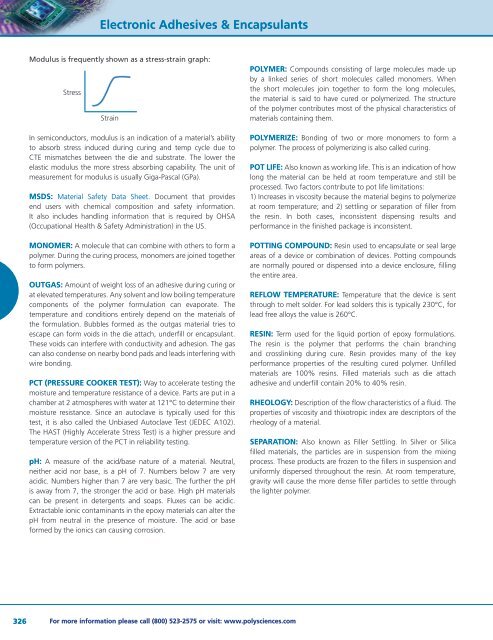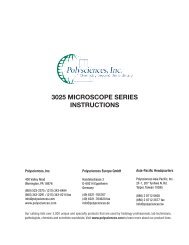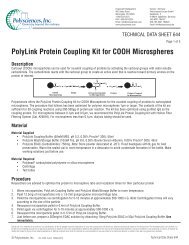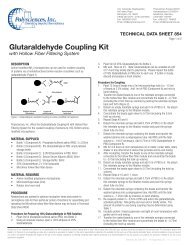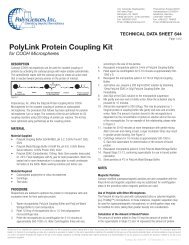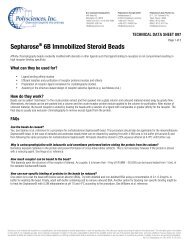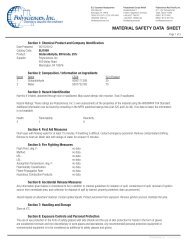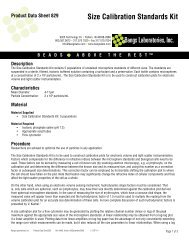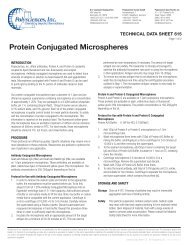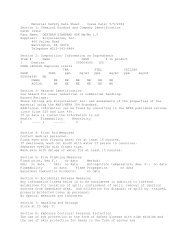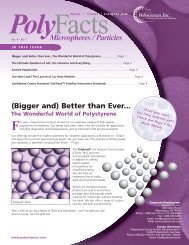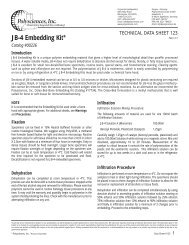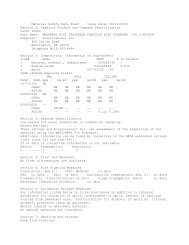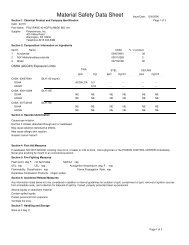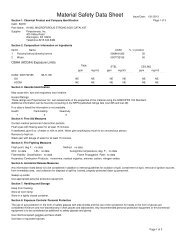BioSciences - Polysciences, Inc.
BioSciences - Polysciences, Inc.
BioSciences - Polysciences, Inc.
You also want an ePaper? Increase the reach of your titles
YUMPU automatically turns print PDFs into web optimized ePapers that Google loves.
326<br />
Electronic Adhesives & Encapsulants<br />
Modulus is frequently shown as a stress-strain graph:<br />
Stress<br />
Strain<br />
In semiconductors, modulus is an indication of a material’s ability<br />
to absorb stress induced during curing and temp cycle due to<br />
CTE mismatches between the die and substrate. The lower the<br />
elastic modulus the more stress absorbing capability. The unit of<br />
measurement for modulus is usually Giga-Pascal (GPa).<br />
MSDS: Material Safety Data Sheet. Document that provides<br />
end users with chemical composition and safety information.<br />
It also includes handling information that is required by OHSA<br />
(Occupational Health & Safety Administration) in the US.<br />
MONOMER: A molecule that can combine with others to form a<br />
polymer. During the curing process, monomers are joined together<br />
to form polymers.<br />
OUTGAS: Amount of weight loss of an adhesive during curing or<br />
at elevated temperatures. Any solvent and low boiling temperature<br />
components of the polymer formulation can evaporate. The<br />
temperature and conditions entirely depend on the materials of<br />
the formulation. Bubbles formed as the outgas material tries to<br />
escape can form voids in the die attach, underfill or encapsulant.<br />
These voids can interfere with conductivity and adhesion. The gas<br />
can also condense on nearby bond pads and leads interfering with<br />
wire bonding.<br />
PCT (PRESSURE COOKER TEST): Way to accelerate testing the<br />
moisture and temperature resistance of a device. Parts are put in a<br />
chamber at 2 atmospheres with water at 121°C to determine their<br />
moisture resistance. Since an autoclave is typically used for this<br />
test, it is also called the Unbiased Autoclave Test (JEDEC A102).<br />
The HAST (Highly Accelerate Stress Test) is a higher pressure and<br />
temperature version of the PCT in reliability testing.<br />
pH: A measure of the acid/base nature of a material. Neutral,<br />
neither acid nor base, is a pH of 7. Numbers below 7 are very<br />
acidic. Numbers higher than 7 are very basic. The further the pH<br />
is away from 7, the stronger the acid or base. High pH materials<br />
can be present in detergents and soaps. Fluxes can be acidic.<br />
Extractable ionic contaminants in the epoxy materials can alter the<br />
pH from neutral in the presence of moisture. The acid or base<br />
formed by the ionics can causing corrosion.<br />
For more information please call (800) 523-2575 or visit: www.polysciences.com<br />
POLYMER: Compounds consisting of large molecules made up<br />
by a linked series of short molecules called monomers. When<br />
the short molecules join together to form the long molecules,<br />
the material is said to have cured or polymerized. The structure<br />
of the polymer contributes most of the physical characteristics of<br />
materials containing them.<br />
POLYMERIZE: Bonding of two or more monomers to form a<br />
polymer. The process of polymerizing is also called curing.<br />
POT LIFE: Also known as working life. This is an indication of how<br />
long the material can be held at room temperature and still be<br />
processed. Two factors contribute to pot life limitations:<br />
1) <strong>Inc</strong>reases in viscosity because the material begins to polymerize<br />
at room temperature; and 2) settling or separation of filler from<br />
the resin. In both cases, inconsistent dispensing results and<br />
performance in the finished package is inconsistent.<br />
POTTING COMPOUND: Resin used to encapsulate or seal large<br />
areas of a device or combination of devices. Potting compounds<br />
are normally poured or dispensed into a device enclosure, filling<br />
the entire area.<br />
REFLOW TEMPERATURE: Temperature that the device is sent<br />
through to melt solder. For lead solders this is typically 230°C, for<br />
lead free alloys the value is 260°C.<br />
RESIN: Term used for the liquid portion of epoxy formulations.<br />
The resin is the polymer that performs the chain branching<br />
and crosslinking during cure. Resin provides many of the key<br />
performance properties of the resulting cured polymer. Unfilled<br />
materials are 100% resins. Filled materials such as die attach<br />
adhesive and underfill contain 20% to 40% resin.<br />
RHEOLOGY: Description of the flow characteristics of a fluid. The<br />
properties of viscosity and thixotropic index are descriptors of the<br />
rheology of a material.<br />
SEPARATION: Also known as Filler Settling. In Silver or Silica<br />
filled materials, the particles are in suspension from the mixing<br />
process. These products are frozen to the fillers in suspension and<br />
uniformly dispersed throughout the resin. At room temperature,<br />
gravity will cause the more dense filler particles to settle through<br />
the lighter polymer.


